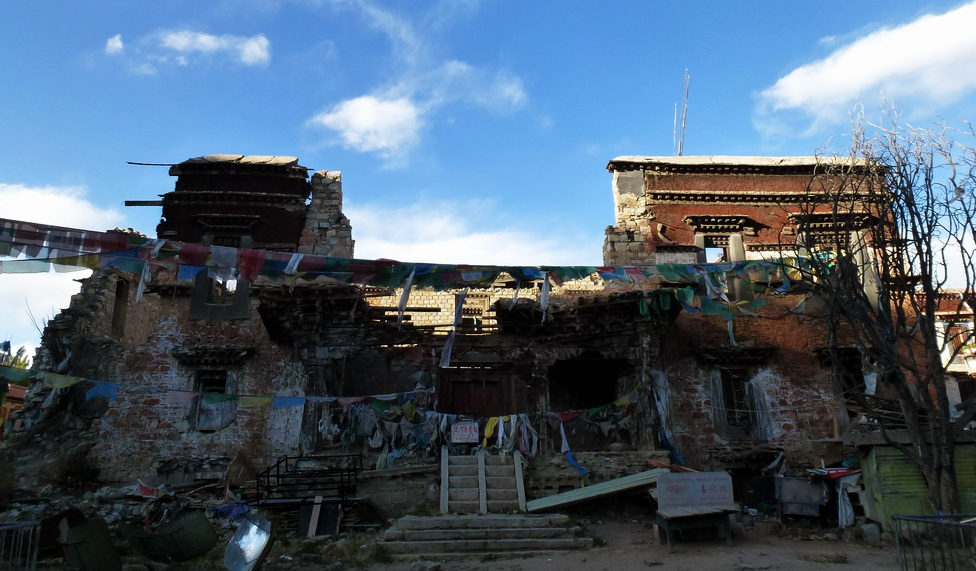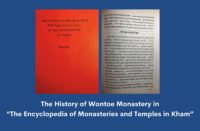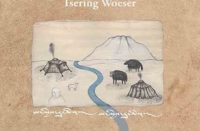High Peaks Pure Earth has translated a blogpost by Woeser written in November 2012 for both the Mandarin service of Radio Free Asia and also for the Tibetan service. Woeser eventually published it on her own blog on December 8, 2012.
The original article in Chinese that prompted Woeser’s response below is “The Patriotic Sentiment that Han Chinese and Tibetans Must Not Forget” by Ji Shuoming, as published in “Asia Weekly in September 2012. The focus of these articles, the 5th Reting Rinpoche, is a controversial figure in modern Tibetan history and recently, Chinese state media has started to report on the activities of the 7th Reting Rinpoche who, at 16, has been appointed to the Tibet Committee of the Chinese People’s Political Consultative Conference. Check back next week for the second part of this article titled “How Was Shideling Destroyed?”.
Congratulations to Woeser on being one of the recipients of the US State Department’s 2013 International Women of Courage Award. The ceremony will be held in Washington DC on March 8, 2013, and Woeser will be awarded in absentia as she and her husband Wang Lixiong are currently under house arrest in Beijing. High Peaks Pure Earth has regularly been translating Woeser’s blog since September 2008 and her poetry can be found in English on the pages of RaggedBanner.com.

“Rewriting the History of the 5th Reting Rinpoche and Shideling”
By Woeser

In the most recent issue of “Asia Weekly” I read the following article online: “The Patriotic Sentiment that Han Chinese and Tibetans Must Not Forget”; the author is Ji Shuoming, a senior journalist working for the magazine. In fact, the two of us happened to meet once before. A few years ago, he interviewed my husband and I to get an understanding of many aspects of the situation in Tibet. I have always believed that media outlets and journalists other than those of the CCP follow the facts when reporting on issues.
However, this article made me lose faith in my previous assumption. Or rather, as I also asked on Twitter and Facebook, “What kind of magazine is ‘Asia Weekly’? Is it the Hong Kong edition of ‘People’s Daily’?” This is because this article was full of the lies that have also been adopted by the CCP and KMT when approaching Tibetan history, it is a clumsy attempt to change history.
A Tibetan academic commented on Facebook: “In what times are we living that we still use categories such as “patriotism”, “loyalty”, or “liberation” to approach recent Tibetan history! I guess the only people that still believe in these kinds of articles are the Han Chinese themselves, while reading the article it was boring and tasteless to even try to refute the arguments in my mind.” I replied: “these kinds of articles are just stereotyping but if you read them you realise that their intentions are very profound. Also, ‘Asia Weekly’ has quite a large readership, so this type of article really propagates lies.”
Let us quickly look at a few parts regarding recent Tibetan history that this article modified using the techniques of the CCP: Reting Rinpoche “was secretly poisoned by separatists back then because he maintained a normal relationship with the Central Government… based on the general situation Reting Rinpoche decided to temporarily resign.”

And this following part is practically the plot of a red TV series broadcast by CCTV: “A loyalist questioned Reting Rinpoche: ‘when did Tibet feel close to China?’ Reting answered with devotion and righteousness: ‘In 1904, the British army under Francis Younghusband forcefully entered Lhasa, the military reparations were assumed by the Chinese Central Government, hence if it had not been for China’s money, how would Tibet have been saved?’”
The following part is even further detached from the facts: “Taktra Rinpoche sent over 3000 Tibetan soldiers to oppress and surround 700 monks in Sera Monastery and under the guidance of the British, they used guns and artillery to attack them… this is an extremely tragic epic of recent Tibetan history written with fresh blood, shocking!”
“Asia Weekly” repeatedly quotes the knowledge that the “Tibet related photographer Yang Kelin” has about Reting Rinpoche and Tibetan history. This Yang Kelin who has “interviewed many important Tibetan leaders” and “has met His Holiness the Dalai Lama over ten times” also passed on the memories of Liu Shengqi, the former KMT secretary of the Mongolian and Tibetan Affairs Commission and later researcher at the Chinese Academy of Social Science; he claimed that the tragedy of the 5th Reting Rinpoche was due to his great love for his country and that he “died for his country”. Yet, Liu Shengqi’s “True Records of Tibet’s Coup d’état” that were written in Lhasa back then actually reveal that Reting was killed out of revenge by a few members of the aristocracy because he had incurred the reigning King’s hatred. Also, they clearly illustrate that the claim that Tibetan soldiers opened fire under foreigners’ guidance is “complete nonsense”.
The most intolerable part of this article is that Shideling was the place that was struck by the Communists in March 1959, that was used as a broadcasting station by the Red Guards and the rebel faction and became a battlefield during the Cultural Revolution and that was, later on, used as a military base for communists troops and in the end, was nothing more than the ruins of Shideling, was presented as Tsechokling Monastery: “After the death of Reting Rinpoche, Taktra Rinpoche sent someone to move his body to Tsechokling Monastery, which was later on taken over by some thugs who burned it down. Hence, Tsechokling Monastery is now in ruins”. Let me add one more sentence, Shideling was not Reting Rinpoche’s residence in Lhasa, it was a place where he would go to practice Buddhism.
The article also mentions that Yang Kelin wants to shoot a documentary and TV series about “The story of how Reting Rinpoche died for his country”, and plans to restore the ruins of Shideling, displaying so-called cultural documents of “ethnic unity” in its interior. In fact, this is an attempt to turn the ruins of Shideling into a red scenic spot, telling all tourists this kind of story: after the great patriot, the 5th Reting Rinpoche, was poisoned by British imperialists and Tibetan separatists, his monastery was destroyed by Tibetan separatists; today, under the efforts of Han-Tibetan unity and all people living in our united ancestral land, it has been restored to its original state. It seems that the project to rewrite the history of Reting Rinpoche and Shideling is already taking place right now. The project to rewrite Tibetan history is still continuing.
Lhasa, October 2012
The photos below are of today’s Shideling and were taken in October and November 2012.








Pingback: High Peaks Pure Earth – “How was Shideling Destroyed?” By Woeser
The lengthy article written on Asia Weekly, the another propaganda machinery tool of CCP is full of lies without any substantial facts. The truth is Reting Rinpoche sold out Tibet to China and therefore got murder by Tibetan nationalist faction who wanted to save Tibet. Whatever he did to help find the reincarnation of thirteenth Dalai Lama is good enough but his serious involvement with power struggle against Taktra Rinpochi and his collaboration with China caused serious irreparable damage towards the cause of Tibet